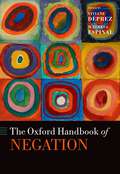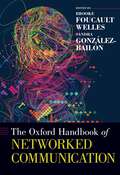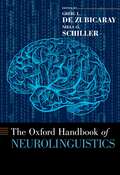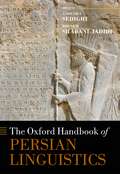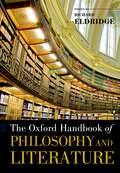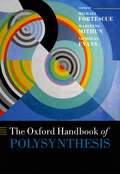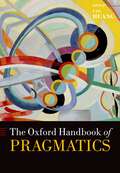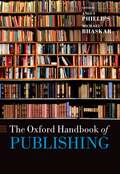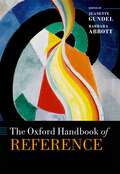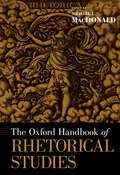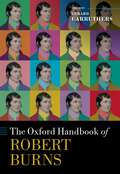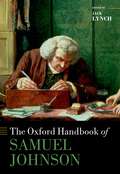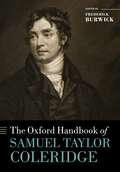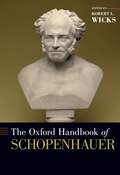- Table View
- List View
The Oxford Handbook of Negation (Oxford Handbooks)
In this volume, international experts in negation provide a comprehensive overview of cross-linguistic and philosophical research in the field, as well as accounts of more recent results from experimental linguistics, psycholinguistics, and neuroscience. The volume adopts an interdisciplinary approach to a range of fundamental questions ranging from why negation displays so many distinct linguistic forms to how prosody and gesture participate in the interpretation of negative utterances. Following an introduction from the editors, the chapters are arranged in eight parts that explore, respectively, the fundamentals of negation; issues in syntax; the syntax-semantics interface; semantics and pragmatics; negative dependencies; synchronic and diachronic variation; the emergence and acquisition of negation; and experimental investigations of negation. The volume will be an essential reference for students and researchers across a wide range of disciplines, and will facilitate further interdisciplinary work in the field.
The Oxford Handbook of Networked Communication (Oxford Handbooks)
by Brooke Foucault Welles Sandra González-BailónCommunication technologies, including the internet, social media, and countless online applications create the infrastructure and interface through which many of our interactions take place today. This form of networked communication creates new questions about how we establish relationships, engage in public, build a sense of identity, and delimit the private domain. The ubiquitous adoption of new technologies has also produced, as a byproduct, new ways of observing the world: many of our interactions now leave a digital trail that, if followed, can help us unravel the rhythms of social life and the complexity of the world we inhabit--and thus help us reconstruct the logic of social order and change. The analysis of digital data requires partnerships across disciplinary boundaries that--although on the rise--are still uncommon. Social scientists and computer scientists have never been closer in their goals of trying to understand communication dynamics, but there are not many venues where they can engage in an open exchange of methods and theoretical insights. This handbook brings together scholars across the social and technological sciences to lay the foundations of communication research in the networked age, and to provide a canon of how research should be conducted in the digital era. The contributors highlight the main theories currently guiding their research in digital communication, and discuss state-of-the-art methodological tools, including automated text analysis, the analysis of networks, and the use of natural experiments in virtual environments. Following a general introduction, the handbook covers network and information flow, communication and organizational dynamics, interactions and social capital, mobility and space, political communication and behavior, and the ethics of digital research.
The Oxford Handbook of Networked Communication (Oxford Handbooks)
Communication technologies, including the internet, social media, and countless online applications create the infrastructure and interface through which many of our interactions take place today. This form of networked communication creates new questions about how we establish relationships, engage in public, build a sense of identity, and delimit the private domain. The ubiquitous adoption of new technologies has also produced, as a byproduct, new ways of observing the world: many of our interactions now leave a digital trail that, if followed, can help us unravel the rhythms of social life and the complexity of the world we inhabit--and thus help us reconstruct the logic of social order and change. The analysis of digital data requires partnerships across disciplinary boundaries that--although on the rise--are still uncommon. Social scientists and computer scientists have never been closer in their goals of trying to understand communication dynamics, but there are not many venues where they can engage in an open exchange of methods and theoretical insights. This handbook brings together scholars across the social and technological sciences to lay the foundations of communication research in the networked age, and to provide a canon of how research should be conducted in the digital era. The contributors highlight the main theories currently guiding their research in digital communication, and discuss state-of-the-art methodological tools, including automated text analysis, the analysis of networks, and the use of natural experiments in virtual environments. Following a general introduction, the handbook covers network and information flow, communication and organizational dynamics, interactions and social capital, mobility and space, political communication and behavior, and the ethics of digital research.
The Oxford Handbook of Neurolinguistics (Oxford Handbooks)
by GREIG I. DE ZUBICARAY Niels O. SchillerNeurolinguistics is a young and highly interdisciplinary field, with influences from psycholinguistics, psychology, aphasiology, and (cognitive) neuroscience, as well as other fields. Neurolinguistics, like psycholinguistics, covers aspects of language processing; but unlike psycholinguistics, it draws on data from patients with damage to language processing capacities, or the use of modern neuroimaging technologies such as fMRI, TMS, or both. The burgeoning interest in neurolinguistics reflects that an understanding of the neural bases of this data can inform more biologically plausible models of the human capacity for language. The Oxford Handbook of Neurolinguistics provides concise overviews of this rapidly-growing field, and engages a broad audience with an interest in the neurobiology of language. The chapters do not attempt to provide exhaustive coverage, but rather present discussions of prominent questions posed by given topics. The volume opens with essential methodological chapters: Section I, Methods, covers the key techniques and technologies used to study the neurobiology of language today, with chapters structured along the basic divisions of the field. Section II addresses the neurobiology of language acquisition during healthy development and in response to challenges presented by congenital and acquired conditions. Section III covers the many facets of our articulate brain, or speech-language pathology, and the capacity for language production-written, spoken, and signed. Questions regarding how the brain comprehends meaning, including emotions at word and discourse levels, are addressed in Section IV. Finally, Section V reaches into broader territory, characterizing and contextualizing the neurobiology of language with respect to more fundamental neuroanatomical mechanisms and general cognitive domains.
The Oxford Handbook of Neurolinguistics (Oxford Handbooks)
Neurolinguistics is a young and highly interdisciplinary field, with influences from psycholinguistics, psychology, aphasiology, and (cognitive) neuroscience, as well as other fields. Neurolinguistics, like psycholinguistics, covers aspects of language processing; but unlike psycholinguistics, it draws on data from patients with damage to language processing capacities, or the use of modern neuroimaging technologies such as fMRI, TMS, or both. The burgeoning interest in neurolinguistics reflects that an understanding of the neural bases of this data can inform more biologically plausible models of the human capacity for language. The Oxford Handbook of Neurolinguistics provides concise overviews of this rapidly-growing field, and engages a broad audience with an interest in the neurobiology of language. The chapters do not attempt to provide exhaustive coverage, but rather present discussions of prominent questions posed by given topics. The volume opens with essential methodological chapters: Section I, Methods, covers the key techniques and technologies used to study the neurobiology of language today, with chapters structured along the basic divisions of the field. Section II addresses the neurobiology of language acquisition during healthy development and in response to challenges presented by congenital and acquired conditions. Section III covers the many facets of our articulate brain, or speech-language pathology, and the capacity for language production-written, spoken, and signed. Questions regarding how the brain comprehends meaning, including emotions at word and discourse levels, are addressed in Section IV. Finally, Section V reaches into broader territory, characterizing and contextualizing the neurobiology of language with respect to more fundamental neuroanatomical mechanisms and general cognitive domains.
The Oxford Handbook of Persian Linguistics (Oxford Handbooks)
by Pouneh Shabani-Jadidi Anousha SedighiThis handbook offers a comprehensive overview of the field of Persian linguistics, discusses its development, and captures critical accounts of cutting edge research within its major subfields, as well as outlining current debates and suggesting productive lines of future research. Leading scholars in the major subfields of Persian linguistics examine a range of topics split into six thematic parts. Following a detailed introduction from the editors, the volume begins by placing Persian in its historical and typological context in Part I. Chapters in Part II examine topics relating to phonetics and phonology, while Part III looks at approaches to and features of Persian syntax. The fourth part of the volume explores morphology and lexicography, as well as the work of the Academy of Persian Language and Literature. Part V, language and people, covers topics such as language contact and teaching Persian as a foreign language, while the final part examines psycho- neuro-, and computational linguistics. The volume will be an essential resource for all scholars with an interest in Persian language and linguistics.
The Oxford Handbook of Persian Linguistics (Oxford Handbooks)
This handbook offers a comprehensive overview of the field of Persian linguistics, discusses its development, and captures critical accounts of cutting edge research within its major subfields, as well as outlining current debates and suggesting productive lines of future research. Leading scholars in the major subfields of Persian linguistics examine a range of topics split into six thematic parts. Following a detailed introduction from the editors, the volume begins by placing Persian in its historical and typological context in Part I. Chapters in Part II examine topics relating to phonetics and phonology, while Part III looks at approaches to and features of Persian syntax. The fourth part of the volume explores morphology and lexicography, as well as the work of the Academy of Persian Language and Literature. Part V, language and people, covers topics such as language contact and teaching Persian as a foreign language, while the final part examines psycho- neuro-, and computational linguistics. The volume will be an essential resource for all scholars with an interest in Persian language and linguistics.
The Oxford Handbook of Philosophy and Literature (Oxford Handbooks)
The Oxford Handbook of Philosophy and Literature contains twenty-three newly commissioned essays by major philosophers and literary scholars that investigate literature as a form of attention to human life. Various forms of attention are considered under the headings of Genres (from Ancient Epic to the Novel and Contemporary Experimental Writing), Periods (from Realism and Romanticism to Postcolonialism), Devices and Powers (Imagination, Plot, Character, Style, and Emotion), and Contexts and Uses (in relation to inquiry, morality, and politics). In each case, the effort is to track and evaluate how specific modes and works of imaginative literature answer to important needs of human subjects for orientation, the articulation of interest in life, and the working through of emotion, within situations that are both sociohistorical and human. Hence these essays show how and why literature matters in manifold ways in and for human cultural life, and they show how philosophers and imaginative literary writers have continually both engaged with and criticized each other.
The Oxford Handbook of Polysynthesis (Oxford Handbooks)
by Nicholas Evans Marianne Mithun Michael FortescueThis handbook offers an extensive crosslinguistic and cross-theoretical survey of polysynthetic languages, in which single multi-morpheme verb forms can express what would be whole sentences in English. These languages and the problems they raise for linguistic analyses have long featured prominently in language descriptions, and yet the essence of polysynthesis remains under discussion, right down to whether it delineates a distinct, coherent type, rather than an assortment of frequently co-occurring traits. Chapters in the first part of the handbook relate polysynthesis to other issues central to linguistics, such as complexity, the definition of the word, the nature of the lexicon, idiomaticity, and to typological features such as argument structure and head marking. Part two contains areal studies of those geographical regions of the world where polysynthesis is particularly common, such as the Arctic and Sub-Arctic and northern Australia. The third part examines diachronic topics such as language contact and language obsolence, while part four looks at acquisition issues in different polysynthetic languages. Finally, part five contains detailed grammatical descriptions of over twenty languages which have been characterized as polysynthetic, with special attention given to the presence or absence of potentially criterial features.
The Oxford Handbook of Polysynthesis (Oxford Handbooks)
This handbook offers an extensive crosslinguistic and cross-theoretical survey of polysynthetic languages, in which single multi-morpheme verb forms can express what would be whole sentences in English. These languages and the problems they raise for linguistic analyses have long featured prominently in language descriptions, and yet the essence of polysynthesis remains under discussion, right down to whether it delineates a distinct, coherent type, rather than an assortment of frequently co-occurring traits. Chapters in the first part of the handbook relate polysynthesis to other issues central to linguistics, such as complexity, the definition of the word, the nature of the lexicon, idiomaticity, and to typological features such as argument structure and head marking. Part two contains areal studies of those geographical regions of the world where polysynthesis is particularly common, such as the Arctic and Sub-Arctic and northern Australia. The third part examines diachronic topics such as language contact and language obsolence, while part four looks at acquisition issues in different polysynthetic languages. Finally, part five contains detailed grammatical descriptions of over twenty languages which have been characterized as polysynthetic, with special attention given to the presence or absence of potentially criterial features.
The Oxford Handbook of Pragmatics (Oxford Handbooks)
by Yan HuangThis volume brings together distinguished scholars from all over the world to present an authoritative, thorough, and yet accessible state-of-the-art survey of current issues in pragmatics. Following an introduction by the editor, the volume is divided into five thematic parts. Chapters in Part I are concerned with schools of thought, foundations, and theories, while Part II deals with central topics in pragmatics, including implicature, presupposition, speech acts, deixis, reference, and context. In Part III, the focus is on cognitively-oriented pragmatics, covering topics such as computational, experimental, and neuropragmatics. Part IV takes a look at socially and culturally-oriented pragmatics such as politeness/impoliteness studies, cross- and intercultural, and interlanguage pragmatics. Finally, the chapters in Part V explore the interfaces of pragmatics with semantics, grammar, morphology, the lexicon, prosody, language change, and information structure. The Oxford Handbook of Pragmatics will be an indispensable reference for scholars and students of pragmatics of all theoretical stripes. It will also be a valuable resource for linguists in other fields, including philosophy of language, semantics, morphosyntax, prosody, psycholinguistics, and sociolinguistics, and for researchers and students in the fields of cognitive science, artificial intelligence, computer science, anthropology, and sociology.
The Oxford Handbook of Pragmatics (Oxford Handbooks)
This volume brings together distinguished scholars from all over the world to present an authoritative, thorough, and yet accessible state-of-the-art survey of current issues in pragmatics. Following an introduction by the editor, the volume is divided into five thematic parts. Chapters in Part I are concerned with schools of thought, foundations, and theories, while Part II deals with central topics in pragmatics, including implicature, presupposition, speech acts, deixis, reference, and context. In Part III, the focus is on cognitively-oriented pragmatics, covering topics such as computational, experimental, and neuropragmatics. Part IV takes a look at socially and culturally-oriented pragmatics such as politeness/impoliteness studies, cross- and intercultural, and interlanguage pragmatics. Finally, the chapters in Part V explore the interfaces of pragmatics with semantics, grammar, morphology, the lexicon, prosody, language change, and information structure. The Oxford Handbook of Pragmatics will be an indispensable reference for scholars and students of pragmatics of all theoretical stripes. It will also be a valuable resource for linguists in other fields, including philosophy of language, semantics, morphosyntax, prosody, psycholinguistics, and sociolinguistics, and for researchers and students in the fields of cognitive science, artificial intelligence, computer science, anthropology, and sociology.
The Oxford Handbook of Publishing (Oxford Handbooks Ser.)
by Angus Phillips Michael BhaskarPublishing is one of the oldest and most influential businesses in the world. It remains an essential creative and knowledge industry, worth over $140 billion a year, which continues to shape our education and culture. Two trends make this a particularly exciting time. The first is the revolution in communications technology that has transformed what it means to publish; far from resting on their laurels and retreating into tradition, publishers are doing as they always have - staying on the cutting edge. The second is the growing body of academic work that studies publishing in its many forms. Both mean that there has never been a more important time to examine this essential practice and the current state of knowledge. The Oxford Handbook of Publishing marks the coming of age of the scholarship in publishing studies with a comprehensive exploration of current research, featuring contributions from both industry professionals and internationally renowned scholars on subjects such as copyright, corporate social responsibility, globalizing markets, and changing technology. This authoritative volume looks at the relationship of the book publishing industry with other media, and how intellectual property underpins what publishers do. It outlines the complex and risky economics of the industry and examines how marketing, publicity, and sales have become ever more central aspects of business practice, while also exploring different sectors in depth and giving full treatment to the transformational and much discussed impact of digital publishing. This Handbook is essential reading for anyone interested in publishing, literature, and the business of media, entertainment, culture, communication, and information.
The Oxford Handbook of Publishing
Publishing is one of the oldest and most influential businesses in the world. It remains an essential creative and knowledge industry, worth over $140 billion a year, which continues to shape our education and culture. Two trends make this a particularly exciting time. The first is the revolution in communications technology that has transformed what it means to publish; far from resting on their laurels and retreating into tradition, publishers are doing as they always have - staying on the cutting edge. The second is the growing body of academic work that studies publishing in its many forms. Both mean that there has never been a more important time to examine this essential practice and the current state of knowledge. The Oxford Handbook of Publishing marks the coming of age of the scholarship in publishing studies with a comprehensive exploration of current research, featuring contributions from both industry professionals and internationally renowned scholars on subjects such as copyright, corporate social responsibility, globalizing markets, and changing technology. This authoritative volume looks at the relationship of the book publishing industry with other media, and how intellectual property underpins what publishers do. It outlines the complex and risky economics of the industry and examines how marketing, publicity, and sales have become ever more central aspects of business practice, while also exploring different sectors in depth and giving full treatment to the transformational and much discussed impact of digital publishing. This Handbook is essential reading for anyone interested in publishing, literature, and the business of media, entertainment, culture, communication, and information.
The Oxford Handbook of Reference (Oxford Handbooks)
by Barbara Abbott Jeanette GundelThis handbook presents an overview of the phenomenon of reference - the ability to refer to and pick out entities - which is an essential part of human language and cognition. In the volume's 21 chapters, international experts in the field offer a critical account of all aspects of reference from a range of theoretical perspectives. Chapters in the first part of the book are concerned with basic questions related to different types of referring expression and their interpretation. They address questions about the role of the speaker - including speaker intentions - and of the addressee, as well as the role played by the semantics of the linguistic forms themselves in establishing reference. This part also explores the nature of such concepts as definite and indefinite reference and specificity, and the conditions under which reference may fail. The second part of the volume looks at implications and applications, with chapters covering such topics as the acquisition of reference by children, the processing of reference both in the human brain and by machines. The volume will be of interest to linguists in a wide range of subfields, including semantics, pragmatics, computational linguistics, and psycho- and neurolinguistics, as well as scholars in related fields such as philosophy and computer science.
The Oxford Handbook of Reference (Oxford Handbooks)
This handbook presents an overview of the phenomenon of reference - the ability to refer to and pick out entities - which is an essential part of human language and cognition. In the volume's 21 chapters, international experts in the field offer a critical account of all aspects of reference from a range of theoretical perspectives. Chapters in the first part of the book are concerned with basic questions related to different types of referring expression and their interpretation. They address questions about the role of the speaker - including speaker intentions - and of the addressee, as well as the role played by the semantics of the linguistic forms themselves in establishing reference. This part also explores the nature of such concepts as definite and indefinite reference and specificity, and the conditions under which reference may fail. The second part of the volume looks at implications and applications, with chapters covering such topics as the acquisition of reference by children, the processing of reference both in the human brain and by machines. The volume will be of interest to linguists in a wide range of subfields, including semantics, pragmatics, computational linguistics, and psycho- and neurolinguistics, as well as scholars in related fields such as philosophy and computer science.
The Oxford Handbook of Rhetorical Studies (Oxford Handbooks)
by Michael J. MacDonaldOne of the most remarkable trends in the humanities and social sciences in recent decades has been the resurgence of interest in the history, theory, and practice of rhetoric: in an age of global media networks and viral communication, rhetoric is once again "contagious" and "communicable" (Friedrich Nietzsche). Featuring sixty commissioned chapters by eminent scholars of rhetoric from twelve countries, The Oxford Handbook of Rhetorical Studies offers students and teachers an engaging and sophisticated introduction to the multidisciplinary field of rhetorical studies. The Handbook traces the history of Western rhetoric from ancient Greece and Rome to the present and surveys the role of rhetoric in more than thirty academic disciplines and fields of social practice. This combination of historical and topical approaches allows readers to chart the metamorphoses of rhetoric over the centuries while mapping the connections between rhetoric and law, politics, science, education, literature, feminism, poetry, composition, philosophy, drama, criticism, digital media, art, semiotics, architecture, and other fields. Chapters provide the information expected of a handbook-discussion of key concepts, texts, authors, problems, and critical debates-while also posing challenging questions and advancing new arguments. In addition to offering an accessible and comprehensive introduction to rhetoric in the European and North American context, the Handbook includes a timeline of major works of rhetorical theory, translations of all Greek and Latin passages, extensive cross-referencing between chapters, and a glossary of more than three hundred rhetorical terms. These features will make this volume a valuable scholarly resource for students and teachers in rhetoric, English, classics, comparative literature, media studies, communication, and adjacent fields. As a whole, the Handbook demonstrates that rhetoric is not merely a form of stylish communication but a pragmatic, inventive, and critical art that operates in myriad social contexts and academic disciplines.
The Oxford Handbook of Rhetorical Studies (Oxford Handbooks)
One of the most remarkable trends in the humanities and social sciences in recent decades has been the resurgence of interest in the history, theory, and practice of rhetoric: in an age of global media networks and viral communication, rhetoric is once again "contagious" and "communicable" (Friedrich Nietzsche). Featuring sixty commissioned chapters by eminent scholars of rhetoric from twelve countries, The Oxford Handbook of Rhetorical Studies offers students and teachers an engaging and sophisticated introduction to the multidisciplinary field of rhetorical studies. The Handbook traces the history of Western rhetoric from ancient Greece and Rome to the present and surveys the role of rhetoric in more than thirty academic disciplines and fields of social practice. This combination of historical and topical approaches allows readers to chart the metamorphoses of rhetoric over the centuries while mapping the connections between rhetoric and law, politics, science, education, literature, feminism, poetry, composition, philosophy, drama, criticism, digital media, art, semiotics, architecture, and other fields. Chapters provide the information expected of a handbook-discussion of key concepts, texts, authors, problems, and critical debates-while also posing challenging questions and advancing new arguments. In addition to offering an accessible and comprehensive introduction to rhetoric in the European and North American context, the Handbook includes a timeline of major works of rhetorical theory, translations of all Greek and Latin passages, extensive cross-referencing between chapters, and a glossary of more than three hundred rhetorical terms. These features will make this volume a valuable scholarly resource for students and teachers in rhetoric, English, classics, comparative literature, media studies, communication, and adjacent fields. As a whole, the Handbook demonstrates that rhetoric is not merely a form of stylish communication but a pragmatic, inventive, and critical art that operates in myriad social contexts and academic disciplines.
The Oxford Handbook of Robert Burns (Oxford Handbooks)
by Gerard CarruthersThe Oxford Handbook of Robert Burns treats the extensive writing of and culture surrounding Scotland's national 'bard'. Robert Burns (1759-96) was a producer of lyrical verse, satirical poetry, in English and Scots, a song-writer and song-collector, a writer of bawdry, journals, commonplace books and correspondence. Sculpting his own image, his untutored rusticity was a sincere persona as much as it was not entirely accurate. Burns was an antiquarian, national patriot, pioneer of what today we would call 'folk culture', and a man of the Enlightenment and Romanticism. The Handbook considers Burns's reception in his own time and beyond, extending to his iconic status as a world-writer. Burns was important to the English Romantic poets, in the context of debates about Abolition in the US, in the Victorian era he was widely utilised as a model for different kinds of popular poetry and he has been utilised as a contestant in debates surrounding Scottish and, indeed, British politics, in peacetime and in wartime down to the present day. The writer's afterlife includes not only a large number of biographies but a whole culture of commemoration in art, architecture, fiction, material culture, museum-exhibition and even forged manuscripts and memorabilia as well as appearances, apparently, via Spiritualist seances. The politics of his work channel the fierce debates of late eighteenth-century Scottish ecclesiastical controversy as well as the ages of American, Agrarian and French revolutions. All of this ground is traversed in this Handbook, the largest critical compendium ever assembled about Robert Burns.
The Oxford Handbook of Robert Burns (Oxford Handbooks)
The Oxford Handbook of Robert Burns treats the extensive writing of and culture surrounding Scotland's national 'bard'. Robert Burns (1759-96) was a producer of lyrical verse, satirical poetry, in English and Scots, a song-writer and song-collector, a writer of bawdry, journals, commonplace books and correspondence. Sculpting his own image, his untutored rusticity was a sincere persona as much as it was not entirely accurate. Burns was an antiquarian, national patriot, pioneer of what today we would call 'folk culture', and a man of the Enlightenment and Romanticism. The Handbook considers Burns's reception in his own time and beyond, extending to his iconic status as a world-writer. Burns was important to the English Romantic poets, in the context of debates about Abolition in the US, in the Victorian era he was widely utilised as a model for different kinds of popular poetry and he has been utilised as a contestant in debates surrounding Scottish and, indeed, British politics, in peacetime and in wartime down to the present day. The writer's afterlife includes not only a large number of biographies but a whole culture of commemoration in art, architecture, fiction, material culture, museum-exhibition and even forged manuscripts and memorabilia as well as appearances, apparently, via Spiritualist seances. The politics of his work channel the fierce debates of late eighteenth-century Scottish ecclesiastical controversy as well as the ages of American, Agrarian and French revolutions. All of this ground is traversed in this Handbook, the largest critical compendium ever assembled about Robert Burns.
The Oxford Handbook of Samuel Johnson (Oxford Handbooks)
by Jack LynchNo major author worked in more genres than Samuel Johnson—essays, poetry, fiction, criticism, biography, scholarly editing, lexicography, translation, sermons, journalism. His works are more extensive than those of any other canonical English writer, and no earlier writer's life was documented as thoroughly by contemporaries. Because it's so difficult to know him thoroughly, people have made do with surrogates and simplifications. But Johnson was much more complicated than the popular image of 'Dr. Johnson' suggests: socially conservative but also one of the most radical abolitionists of his age, a firm believer in social hierarchy but an outspoken supporter of women intellectuals, an uncompromising Christian moralist but also a penetrating critic of family structures. Labels fit him poorly. In The Oxford Handbook of Samuel Johnson, an international team of thirty-six scholars offers the most comprehensive examination ever attempted of one of the most complex figures in English literature. The book's first section examines Johnson's life and the texts of his works; the second, organized by genre, explores all his major works and many of his minor ones; the third, organized by topic, covers the subjects that were most important to him as a writer, as a thinker, and as a moralist.
The Oxford Handbook of Samuel Johnson (Oxford Handbooks)
No major author worked in more genres than Samuel Johnson—essays, poetry, fiction, criticism, biography, scholarly editing, lexicography, translation, sermons, journalism. His works are more extensive than those of any other canonical English writer, and no earlier writer's life was documented as thoroughly by contemporaries. Because it's so difficult to know him thoroughly, people have made do with surrogates and simplifications. But Johnson was much more complicated than the popular image of 'Dr. Johnson' suggests: socially conservative but also one of the most radical abolitionists of his age, a firm believer in social hierarchy but an outspoken supporter of women intellectuals, an uncompromising Christian moralist but also a penetrating critic of family structures. Labels fit him poorly. In The Oxford Handbook of Samuel Johnson, an international team of thirty-six scholars offers the most comprehensive examination ever attempted of one of the most complex figures in English literature. The book's first section examines Johnson's life and the texts of his works; the second, organized by genre, explores all his major works and many of his minor ones; the third, organized by topic, covers the subjects that were most important to him as a writer, as a thinker, and as a moralist.
The Oxford Handbook of Samuel Taylor Coleridge (Oxford Handbooks)
A practical and comprehensive reference work, the Oxford Handbook provides the best single-volume source of original scholarship on all aspects of Coleridge's diverse writings. Thirty-seven chapters, bringing together the wisdome of experts from across the world, present an authoritative, in-depth, and up-to-date assessment of a major author of British Romanticism. The book is divided into sections on Biography, Prose Works, Poetic Works, Sources and Influences, and Reception. The Coleridge scholar today has ready access to a range of materials previously available only in library archives on both sides of the Atlantic. The Bollingen edition, of the Collected Works of Samuel Taylor Coleridge, forty years in production was completed in 2002. The Coleridge Notebooks (1957-2002) were also produced during this same period, five volumes of text with an additional five companion volumes of notes. The Clarendon Press of Oxford published the letters in six volumes (1956-1971). To take full advantage of the convenient access and new insight provided by these volumes, the Oxford Handbook examines the entire range and complexity of Coleridge's career. It analyzes the many aspects of Coleridge's literary, critical, philosophical, and theological pursuits, and it furnishes both students and advanced scholars with the proper tools for assimilating and illuminating Coleridge's rich and varied accomplishments, as well as offering an authoritative guide to the most up-to-date thinking about his achievements.
The Oxford Handbook of Schopenhauer (Oxford Handbooks)
by Robert L. WicksMore than two hundred years after the publication of his seminal The World as Will and Representation, Arthur Schopenhauer's influence is still felt in philosophy and beyond. As one of the most readable and central philosophers of the 19th century, his work inspired the most influential thinkers and artists of his time, including Nietzsche, Freud, and Wagner. Though known primarily as a herald of philosophical pessimism, the full range of his contributions is displayed here in a collection of thirty-one essays on the forefront of Schopenhauer scholarship. Essays written by contemporary Schopenhauer scholars explore his central notions, including the will, empirical knowledge, and the sublime, and widens to the interplay of ethics and religion with Schopenhauer's philosophy. Authors confront difficult aspects of Schopenhauer's work and legacy--for example, the extent to which Schopenhauer adopted ideas from his predecessors compared to how much was original and visionary in his central claim that reality is a blind, senseless "will," the effectiveness of his philosophy in the field of scientific explanation and extrasensory phenomena, and the role of beauty and sublimity in his outlook. Essays also challenge prevailing assumptions about Schopenhauer by exploring the fundamental role of compassion in his moral theory, the Hindu, Christian, and Buddhist aspects of his philosophy, and the importance of asceticism in his views on the meaning of life. The collection is an internationally constituted work that reflects upon Schopenhauer's philosophy with authors presently working across the globe. It demonstrates fully the richness of Schopenhauer's work and his lasting impact on philosophy and psychoanalysis, as well as upon music, the visual arts, and literature.
The Oxford Handbook of Schopenhauer (Oxford Handbooks)
More than two hundred years after the publication of his seminal The World as Will and Representation, Arthur Schopenhauer's influence is still felt in philosophy and beyond. As one of the most readable and central philosophers of the 19th century, his work inspired the most influential thinkers and artists of his time, including Nietzsche, Freud, and Wagner. Though known primarily as a herald of philosophical pessimism, the full range of his contributions is displayed here in a collection of thirty-one essays on the forefront of Schopenhauer scholarship. Essays written by contemporary Schopenhauer scholars explore his central notions, including the will, empirical knowledge, and the sublime, and widens to the interplay of ethics and religion with Schopenhauer's philosophy. Authors confront difficult aspects of Schopenhauer's work and legacy--for example, the extent to which Schopenhauer adopted ideas from his predecessors compared to how much was original and visionary in his central claim that reality is a blind, senseless "will," the effectiveness of his philosophy in the field of scientific explanation and extrasensory phenomena, and the role of beauty and sublimity in his outlook. Essays also challenge prevailing assumptions about Schopenhauer by exploring the fundamental role of compassion in his moral theory, the Hindu, Christian, and Buddhist aspects of his philosophy, and the importance of asceticism in his views on the meaning of life. The collection is an internationally constituted work that reflects upon Schopenhauer's philosophy with authors presently working across the globe. It demonstrates fully the richness of Schopenhauer's work and his lasting impact on philosophy and psychoanalysis, as well as upon music, the visual arts, and literature.
